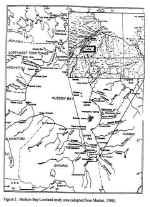|
1998.
M.Sc., 196 pp.
CHARACTERIZATION OF SEASONAL BACKSCATTER CHANGE IN SUBARCTIC
WETLANDS AND RIVER ICE BREAKUP USING RADARSAT DATA
Murphy
M.
 The first objective of this research was to describe
the backscatter response of Radarsat images to seasonal changes in the Hudson
Bay Lowland. The second objective was to evaluate the potential of Radarsat
images for predicting river ice cover breakup. Six Standard Mode images from
spring, summer and fall, 1996 were used for the first objective. The backscatter
response from numerous land covers was assessed and plotted over time.
Environmental changes influenced backscatter more than incidence angle.
Backscatter was low in spring due to the wet snow cover. Backscatter increased
to a June peak because of the disappearance of snow and the increasing moisture
content of vegetation. A decline into August was tied to declining amounts of
water in vegetation and surface layers and a further backscatter decline into
November was tied to deposition of new wet snow. Spring was found to be the best
time of year for distinguishing between the land covers. Five Fine Mode images
were used for the second objective. Three were pre-breakup and two were
post-breakup. The images show many features indicative of approaching breakup
including cracks, shear zones and texture changes from consistently mottled to
distinctly patchy with circular, transverse and longitudinal bright features.
Ice backscatter declined 2 to 4 dB from three weeks prior to just before
breakup. The first objective of this research was to describe
the backscatter response of Radarsat images to seasonal changes in the Hudson
Bay Lowland. The second objective was to evaluate the potential of Radarsat
images for predicting river ice cover breakup. Six Standard Mode images from
spring, summer and fall, 1996 were used for the first objective. The backscatter
response from numerous land covers was assessed and plotted over time.
Environmental changes influenced backscatter more than incidence angle.
Backscatter was low in spring due to the wet snow cover. Backscatter increased
to a June peak because of the disappearance of snow and the increasing moisture
content of vegetation. A decline into August was tied to declining amounts of
water in vegetation and surface layers and a further backscatter decline into
November was tied to deposition of new wet snow. Spring was found to be the best
time of year for distinguishing between the land covers. Five Fine Mode images
were used for the second objective. Three were pre-breakup and two were
post-breakup. The images show many features indicative of approaching breakup
including cracks, shear zones and texture changes from consistently mottled to
distinctly patchy with circular, transverse and longitudinal bright features.
Ice backscatter declined 2 to 4 dB from three weeks prior to just before
breakup.
|